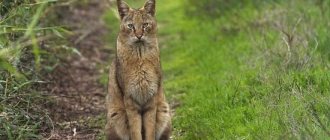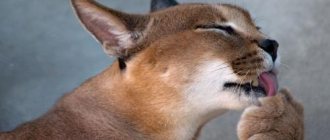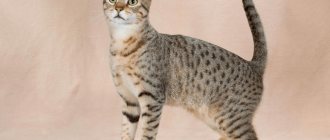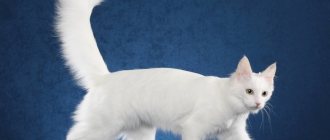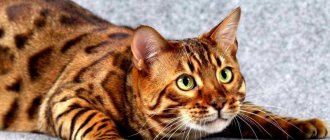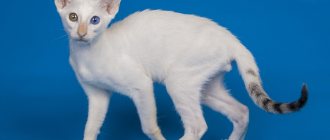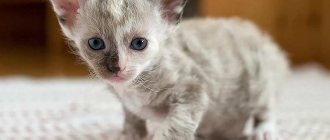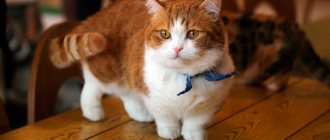If you love wild cats, then you will love the Serengeti. Amazing representatives of the tribe, have a spotted color reminiscent of a cheetah, as well as its flexibility and grace.
The Serengeti is a new breed, so its numbers are not large. It numbers only a few hundred individuals. The price for a kitten is very high and ranges from 2 to 10 thousand dollars.
History of appearance
The Serengeti breed originated in the USA.
Breeder Karen Sauzman decided to breed a domestic cat with the appearance of a wild beast, a serval. Such attempts have already been made before. For example, savannah. It is a cross between an African bush cat and a domestic cat. But there are difficulties in breeding this breed. Males from the 1st to 3rd generation are born sterile, and subsequent descendants of servals gradually lose their resemblance to the African beast. Sauzman decided to change her approach to crossbreeding. She wanted to get a new breed without the blood of a wild animal. Bengals were crossed with spotted Orientals. This choice was not accidental - Bengal cats passed on to their descendants a large body size and bright color, and oriental beauties shared an elegant appearance, long limbs and large ears, and the spotted print on the coat also did not turn out to be superfluous. Later, the Serengeti cats received the blood of Maine Coons and Abyssinians.
Serengeti looks like a wild cat
The result was presented in 1994. A new breed of cat has appeared with the striking appearance of a wild African cat. The breeder gave her a euphonious name - Serengeti. This is the name of a protected area in Tanzania, where a large population of servals lives. The Serengeti cat breed was registered as an experimental felinological organization TICA, but its representatives do not yet have the right to take part in exhibitions and championships.
What's prohibited
Has official status in TICA (International Cat Association).
But due to the fact that at the moment the conditions (at least 50 nurseries) under which the breed is allowed for exhibitions are not met, they are not exhibited.
Appearance
If we take the external description of the Serengeti, they are very similar to the serval. They have a muscular body, long legs and neck, and large ears. Silky wool most often has a spotted color.
Serengeti cat color
The coat of Serengeti cats has a honey, smoky or gray background color with beautiful spots of chocolate or black. The breed standard identifies the main colors, which are called:
- black spotted tabby (contrasting spots);
- black ghost spot;
- smoky or gray ghost spotting.
The spots should be horizontal, round and slightly elongated; the presence of a dark path from the inner corners of the eyes is welcome.
The coat color of the new breed is truly exotic
Dimensions and anatomical features
The average weight of cats is from 8 to 10 kg, cats can reach 15 kg. Height is about 60 cm.
The head of the Serengeti is elongated, it expands evenly from the nose to the base of the ears. Cheekbones and cheeks are practically not prominent; the profile is a straight line from the nose to the eyebrows. The chin is clearly defined, the nose is moderately wide, often with a black edging. The neck is long, rather thick, expanding from the head to the body.
The ears of this breed are very large, almost as long as the muzzle, set vertically, set high on the back of the head close to each other. They are wide and deep at the base, the tips are rounded.
The Serengeti has large round eyes, the distance between them is slightly larger than the size of one eye. The preferred color is golden or yellow, light green or hazel is acceptable.
The photo shows that the Serengeti cat is a large animal
Serengeti cats have a strong, long body, a straight line of the back and hips, and shoulders that are approximately the same width as them. The legs are very high, strong and muscular, with medium-sized oval-shaped paws. The tail can vary in length from medium to short, but the preferred size is up to the animal's shoulder. The shape of the tail is wide at the base, tapering towards the end, the tip is always black.
Colors
According to the standard, the spots of this breed are round and oval in shape and located horizontally.
There are several standard colors of the Serengeti breed:
- Black tabby (spotted). The color of the spots is bright, contrasting with the main color.
- Black. In these cases, the color of the animal is darker, the markings are bright, but do not stand out strongly against the main color of the coat.
- Gray-smoky. The coat color is gray, the spots are black.
Character
Serengeti cats are very talkative cats. The talkativeness of this breed is their specific feature. They can follow their owner and purr, mumble, click and coo. Sometimes this, of course, is tiring, but you will not be able to convince the cat to remain silent.
The Serengeti cat is quite stubborn. If she wants something, then there is no point in hiding it in the farthest room. Because the Serengeti will overcome all obstacles, and the treasured thing will end up in its muscular paws. To divert your cat's attention from valuable interior items, provide her with a sufficient number of toys.
Serengeti are talkative, stubborn and very brave
Fearlessness is another trait of the Serengeti cat. They, as descendants of wild animals, are not afraid of any street dogs. The cat has a fighting character, so do not let the animal walk alone on the street - suddenly it will encounter an opponent that is too tough for it, or rather, too strong for it.
The Serengeti has strong leadership qualities. In the Serengeti house there is a leader. And if the owner accepts such leadership of the breed, then he is rewarded with its tenderness and kindness.
Behavioral features
Serengeti is a cat whose character cannot be described in a few words. She looks nothing like her prototype. Unlike wild servals, Serengeti are affectionate and very smart creatures. Representatives of this breed are quite persistent, curious and even stubborn. They will not run as fast as they can (that is, paws) at the sight of a large dog.
These active and brave cats love to walk and need constant attention from their owners. They cannot stand being alone and will not tolerate rudeness or intimidation. Inappropriate treatment turns these cute creatures into aggressive and irritable animals.
Serengeti, a cat whose reviews are mostly positive, is able to communicate not only through the standard meow. The range of sounds it produces is quite wide. She can imitate growling, slurping, smacking, cooing and even clucking.
In addition, the Serengeti is highly trainable and can easily learn circus tricks. Representatives of this breed have one interesting feature: they consider any objects that they can move with their paws to be toys.
Maintenance and care
There are no special nuances in terms of caring for the Serengeti. It does not leave much fur on the floor, and to collect the falling out undercoat, it is enough to comb the cat every day with a special massage mitt or brush.
Cats of this breed are very clean; they independently remove dirt from their eyes and ears. The main thing is to regularly examine your pet for parasites or unusual changes (for example, redness).
Serengeti are clean and do not leave much fur.
To solve the issue of claw care, just buy a scratching post and place it in a visible place. Also, if possible, it is worth equipping the animal with slides, swings, and a cat tree. Otherwise, the cat will find an opportunity to play by jumping from cabinets onto curtains, tables and other things. She loves secluded places where she can rest quietly, and therefore it is often difficult to find her in the house - the Serengeti is so reliably hidden.
Owner reviews
Since the Serengeti is a relatively new breed, it has not yet gained widespread popularity among ordinary people. But those lucky few who have such cats at home speak of them with great warmth. According to them, this is an ideal option for those who have never had pets. Representatives of this breed are good because they do not require special care, are unpretentious in food and easily get used to a new environment. Some owners even travel with their Serengetis.
These beautiful and incredibly curious cats try to poke their noses everywhere, which is why many professional breeders compare them to researchers. They also say that representatives of this breed are very affectionate and sociable. They try by any means to gain the attention of their owners. Cats can get in the way, poke their noses, caress and paw until the owner understands what they want from him.
In addition, experienced breeders noticed one interesting feature. These playful and very active animals can push fragile objects with their paws. Therefore, those who have a Serengeti kitten in their home need to remove all small and easily breakable objects from the accessibility zone in advance. Otherwise, an animal carried away by the game may accidentally throw them onto the floor and be injured by fragments.
Nutrition
If you make a choice in favor of industrial feed, then representatives of the Serengeti breed should be fed ready-made dry mixtures of the super-premium or holistic class. They are well saturated and contain various vitamins, minerals and amino acids. Since these are large animals, they need to receive approximately one and a half times more calories than representatives of other breeds.
An adult cat should be fed 2 times a day at the same time, and kittens, depending on age, from 3 to 5 times a day.
Serengeti cats require more food than regular cats
Among the owners of purebred cats, there are those who prefer to prepare their diet from natural products. In this case, 70–80% of the total food volume should be meat and offal. Choose low-fat varieties - poultry fillet, beef tenderloin, veal, rabbit. Heart and stomachs can be given 2 times a week.
The remaining 20% of the diet is supplements, such as cereals, vegetables, eggs, and dairy products. You can treat your pet to a piece of cheese, shrimp, fish, and liver once a week. It is forbidden to feed cats fried, spicy, salty foods, sweets, bones, mushrooms, beans, and bread. Don't give bones or whole milk.
Proper feeding
You can feed both industrial feed and natural food.
When choosing ready-made food, preference is given to trusted manufacturers. Food chosen is intended for large breeds.
Chewable treats to clean your teeth are a must.
Brown tabby variety
The basis of natural feeding should be meat, with all the veins and cartilage. By-products are also useful. This diet is supplemented with cereals, fresh vegetables, and fermented milk products of medium fat content.
Important! To prevent the formation of tartar, alternate between hard and soft foods.
Health and life expectancy
Serengeti cats are predisposed to developing urolithiasis. In order not to miss the onset of the disease, you should remember that kidney disease in cats is much less common than in cats. It is also almost impossible to discern the first symptoms. The malaise appears immediately and suddenly.
Suddenly, a Serengeti cat cannot go to the litter box for a long time, begins to lick the opening of the urethra and meow pitifully, unexpectedly urinates in the wrong places, and so on. Self-medication is pointless; only a veterinarian can stop the problem. The veterinarian will also advise what to feed your pet to avoid such diseases.
Otherwise, the Serengeti is a cat of good health. The way the Serengeti looks completely determines its well-being. If she is active and cheerful, then everything is fine.
The breed has excellent health
The lifespan of a cat of this breed is about 10 years.
Video
https://www.youtube.com/embed/
* We invite you to watch a video about the Persian cat breed. In fact, in front of you is a playlist in which you can select and watch any of 20 videos about a given cat breed by simply clicking on the button in the upper right corner of the window. In addition, the material contains quite a lot of photos. By looking at them you can find out what a Persian cat looks like.
| In this article: |
The Persian cat is an ancient and complex breed with the face and habits of a languid, moon-faced beauty of the East. She makes the most mediocre sofa look chic while she sits on it. And after leaving, he leaves a pile of fur and regret for having such a beast. But the Persian can always correct the impression with just one glance and calm him down with affection and a measured hum.
| Material content: |
Breeding
Large cats mature a little later than other breeds. Thus, the first heat of a Serengeti female begins at 8 months, but individuals who have reached one and a half years of age are allowed to mate. Representatives of this breed can be crossed with each other, and mating with Bengals, Orientals and Abyssinians is also allowed. However, the Serengeti cannot be crossed with servals and wild cats. Kittens from such litters will not resemble this breed or will be infertile.
The date for the animals is arranged on the cat's territory. The animals get to know each other for about a day, and then begin mating games. Pregnancy lasts approximately 65–66 days. Kittens are born large - weighing 120–140 g. There are 3–5 cubs in one litter. Breeders hand over babies to new owners at the age of 3–4 months. Vaccination, training kittens to a tray and a scratching post falls on their shoulders.
Such cats grow up quite late
You cannot breed a cat more than once a year. Pregnancy and lactation greatly deplete the body. Full recovery takes on average 10 months.
Buying a Serengeti kitten
Kittens are given to a new family from 3 months. You can choose a Serengeti kitten based on the following criteria. They must have:
- large, straight and high-set ears with rounded tips
- the distance between the eyes is greater than the length of one eye, the eyes themselves are large, almost round, curious;
- drawing, if any, is only spotted tabby;
- Long neck;
- thin tail with a rounded tip;
- the coat should not fit very tightly to the body, there should be little undercoat;
- very long legs;
- absolutely straight back line;
- playfulness, fearlessness, curiosity and high mobility.
The photo shows a Serengeti kitten, ready for a new family.
Catteries where you can buy Serengeti kittens exist in Russia, Europe, America and Australia. There are no more than 1000 such cats in the world. Their price can vary from $500 to $3000.
Mr. Cat recommends: cost of a kitten
The breed is only gaining popularity, and it is all the easier to control the integrity of breeders, of whom there are not many.
The cost of the Serengeti averages 1000-2000 dollars. Cats sold second-hand and at a lower price are ordinary yard species or crosses with other breeds. Therefore, do not try to save money and ask the seller for documents.
Today, many advertisements and information about conscientious breeders have been published on the Internet, who will subsequently become the owner of a Serengeti who will become a real pet.
Photo gallery of cats of the Serengeti breed:
1111
